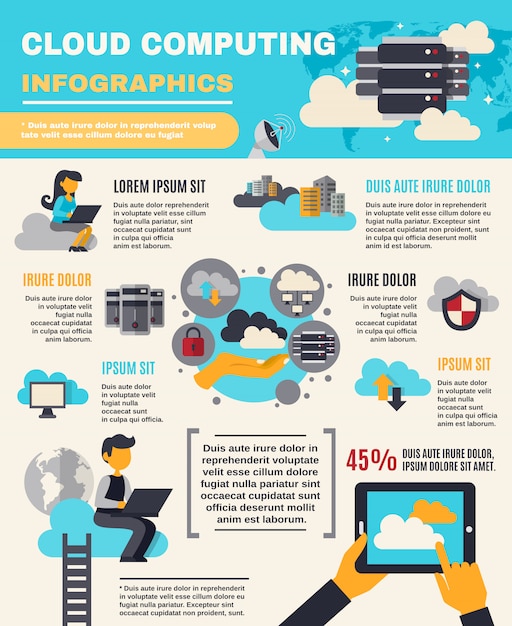US Cloud Computing Growth to 7% by 2025: Global Market Impact Explained

The projected 7% increase in US cloud computing adoption by 2025 is set to solidify the nation’s dominance, driving global market share expansion, fostering innovation in AI and edge computing, and significantly influencing international digital infrastructure and competitive landscapes.
The digital transformation accelerated by the pandemic has cemented cloud computing as an indispensable pillar of modern enterprise. As we approach 2025, projections indicate a remarkable 7% increase in US cloud computing adoption by 2025, a trend that promises to reshape not only the domestic technology landscape but also exert profound influence on the global market share. This surge reflects evolving business needs, technological advancements, and a strategic move towards more agile and scalable IT infrastructures.
Understanding the Trajectory of US Cloud Computing Growth
The United States has long been at the forefront of technological innovation, and cloud computing is no exception. Home to global tech giants and a vibrant startup ecosystem, the US continues to be a fertile ground for cloud adoption and development. This projected 7% increase by 2025 isn’t just a number; it signifies a maturing market, indicating both wider acceptance across industries and deeper integration into core business operations.
This growth is fueled by several factors. Firstly, the ongoing demand for digital services, from streaming entertainment to remote work solutions, necessitates robust and scalable computing power. Cloud platforms offer this flexibility, allowing businesses to adapt quickly to changing market conditions. Secondly, the increasing sophistication of cloud services, including specialized solutions for AI, machine learning, and data analytics, is attracting new users and expanding existing deployments.
Driving Factors Behind Market Expansion
Several key elements contribute to this accelerated adoption rate. Understanding these drivers is crucial to appreciating the magnitude of the impending shift. They range from technological advancements to evolving business models that prioritize efficiency and scalability.
- Digital Transformation Imperative: The widespread push for digital transformation across all sectors compels businesses to migrate to cloud-based solutions for enhanced agility and competitive advantage.
- Innovation in Cloud Services: Continuous advancements in serverless computing, containerization, and platform-as-a-service (PaaS) offerings simplify development and deployment, making cloud more accessible.
- Hybrid and Multi-Cloud Strategies: The growing adoption of hybrid and multi-cloud architectures allows organizations to leverage the best features of different cloud providers and on-premises infrastructure, optimizing cost and performance.
- Focus on Data Analytics and AI: The cloud provides the necessary infrastructure and tools for processing vast amounts of data and running complex AI/ML models, driving demand from data-intensive industries.
The confluence of these factors creates a powerful momentum, propelling US cloud adoption rates significantly higher. Businesses are increasingly recognizing the strategic value of cloud infrastructures, moving beyond mere cost savings to embrace the cloud as a catalyst for innovation and growth.
This expansion also reflects a growing confidence in cloud security and compliance measures. As cloud providers enhance their security protocols and adhere to stringent regulatory frameworks, concerns that once hindered adoption are progressively diminishing, paving the way for even broader enterprise use.
America’s Dominance: Implications for Global Market Share
The US already commands a substantial portion of the global cloud computing market. A further 7% increase in adoption within the US translates into a magnified impact on this global standing. This surge implies that American companies, both cloud providers and consumers of cloud services, will further consolidate their leadership, outpacing growth in many other regions.
The sheer scale of the US economy, coupled with its innovative spirit, positions it uniquely to capitalize on cloud trends. As more US businesses embrace cloud technologies, their increased spending and utilization contribute directly to the global market share figures. This growth isn’t just about revenue; it’s also about setting standards, driving innovation, and influencing the technological direction of the industry worldwide.
Market Share Shifts and Competitive Landscape
This increased US adoption will inevitably lead to shifts in global market share. While major US-based cloud providers like Amazon Web Services (AWS), Microsoft Azure, and Google Cloud Platform (GCP) already dominate, their domestic growth will further strengthen their global positions. This presents both opportunities and challenges for international competitors.
- Reinforced US Provider Leadership: The primary beneficiaries will be the leading US cloud service providers, who will see their revenue and infrastructure expand, allowing for even greater investment in research and development.
- Pressure on Non-US Providers: European and Asian cloud providers may find it harder to compete on scale and innovation without substantial government or private sector investment to accelerate their own cloud ecosystems.
- Rise of Niche Players: While the giants grow, there will still be room for specialized cloud providers offering bespoke solutions, particularly in specific industry verticals or for sovereign cloud requirements in other nations.
- Technological Spillover: Innovations developed within the competitive US cloud market will inevitably spread globally, driving technological advancements and setting new benchmarks for cloud services everywhere.
The investment in cloud infrastructure and services by US enterprises creates a positive feedback loop. Greater adoption leads to more sophisticated solutions, which in turn attract more users, perpetuating the growth cycle. This dynamic makes it challenging for regions with less mature cloud ecosystems to catch up quickly.
Furthermore, the high level of competition among the top US cloud providers often translates into better services, lower costs, and continuous innovation for customers. This competitive edge, honed domestically, extends globally, giving US providers a strong advantage in international markets.
Impact on Global Innovation and Technological Standards
A significant increase in US cloud computing adoption by 2025 will not only affect market share but also deeply influence global innovation and the establishment of technological standards. The US, with its robust R&D ecosystem and significant investment in emerging technologies, is poised to drive the next wave of cloud evolution.
Increased domestic utilization provides a large testing ground for new cloud features, services, and integration models. This rapid feedback loop accelerates innovation, pushing the boundaries of what cloud computing can achieve. From advanced AI and machine learning capabilities to sophisticated edge computing solutions, US adoption will be a major catalyst for these technological advancements.
Frontiers of Cloud Innovation
The projected growth underscores a commitment to pushing technological boundaries. This will manifest in several key areas, influencing how cloud services are delivered and consumed worldwide.
- Artificial Intelligence and Machine Learning: The cloud is the backbone of most AI development. Increased US adoption will mean more powerful, accessible, and integrated AI services that will eventually become global standards.
- Edge Computing Integration: As operations move closer to data sources, the interplay between large centralized clouds and distributed edge computing will become more seamless, with US providers leading the way in developing comprehensive solutions.
- Quantum Computing as a Service: While still nascent, US cloud providers are investing heavily in quantum computing research. Increased cloud adoption could accelerate the offering of quantum resources as cloud services.
- Sustainability in Cloud Infrastructure: With growing environmental concerns, US cloud providers are under pressure to develop more energy-efficient data centers and sustainable cloud practices, setting a global precedent.
These innovations, often incubated and refined within the demanding US market, will subsequently be exported globally, raising the bar for cloud services in other regions. Non-US enterprises and governments will find themselves adopting standards and technologies shaped by the American cloud ecosystem to remain competitive and integrate seamlessly into the global digital economy.

The development of open-source cloud technologies and frameworks within the US also plays a critical role. Contributions from US companies to projects like Kubernetes and TensorFlow establish de facto standards that are adopted internationally, influencing how cloud-native applications are designed and deployed worldwide.
Addressing Geopolitical and Regulatory Challenges
While the increase in US cloud adoption brings significant economic and technological benefits, it also introduces complexities related to geopolitics and regulation. Data sovereignty, privacy concerns, and varied legal frameworks across different nations pose challenges, even for dominant US providers expanding globally.
The Patriot Act and other US legal statutes, for example, can raise concerns in other countries about the access of US authorities to data stored on US-owned cloud infrastructure, even if that infrastructure is located outside the US borders. This can sometimes lead to localized cloud solutions or stringent data residency requirements in certain jurisdictions.
Building Trust and Navigating Compliance
To maintain and expand global market share, US cloud providers must adeptly navigate an increasingly complex international regulatory landscape. Building trust through transparent practices and robust compliance is paramount.
- Data Residency and Sovereignty: Providers must offer solutions that allow data to remain within specific geographic boundaries, respecting local laws and national security concerns.
- Compliance with International Regulations: Adherence to privacy regulations like GDPR (Europe), LGPD (Brazil), and other regional data protection acts is crucial for operating in diverse markets.
- Transparent Security Practices: Clearly communicating security measures, encryption protocols, and incident response plans helps alleviate concerns from international clients and governments.
- Local Partnerships and Alliances: Collaborating with local telecommunication companies and IT service providers can help overcome market entry barriers and address regional specificities.
The ability of US cloud providers to adapt their services and policies to meet these diverse international requirements will be a critical determinant of how effectively they can convert increased domestic strength into sustained global market expansion. Failure to do so could lead to fragmentation of the global cloud market, with regional players emerging to fill the void.
Furthermore, cybersecurity threats are global in nature, and robust defensive capabilities developed within the US cloud ecosystem will be a valuable asset for all users, regardless of their location. Sharing best practices and contributing to international cybersecurity standards will be another important aspect of maintaining global leadership.
Economic Implications for the US and Beyond
The projected 7% increase in US cloud computing adoption by 2025 will have profound economic implications, both domestically and internationally. For the US, it means continued economic growth, job creation in high-tech sectors, and enhanced productivity across industries. This domestic strength will radiate outwards, influencing global economic patterns.
Increased adoption signifies greater capital expenditure on infrastructure, software, and services, driving investment and fostering a robust domestic tech economy. This creates high-skilled jobs and strengthens the US position as a hub for technological talent and innovation, attracting further investment and fostering a virtuous cycle of growth.
Global Economic Ripple Effects
The economic impact extends far beyond US borders, touching various facets of the global economy and shaping international trade in technology services.
- Increased Exports of Cloud Services: As US providers expand and innovate, their ability to export cloud services internationally grows, boosting US service exports and contributing to its balance of trade.
- Empowering Global Businesses: Non-US businesses gain access to advanced, scalable, and cost-effective cloud infrastructure and applications, enabling their own digital transformation and competitive growth.
- Infrastructure Development in Emerging Markets: US cloud providers entering emerging markets often spur local infrastructure development, including data centers and fiber optic networks, creating jobs and opportunities.
- Data Economy Growth: The increasing reliance on cloud computing fuels the global data economy, generating new business models and opportunities for data-driven insights across industries.
The efficiency gains and cost reductions offered by cloud services enable businesses worldwide to reallocate resources towards innovation and growth. This broadens economic participation and fosters a more interconnected and digitally enabled global marketplace, with the US cloud sector serving as a significant enabler.

Furthermore, cloud computing democratizes access to powerful computing resources, allowing smaller businesses and startups in any part of the world to compete more effectively with larger enterprises. This levels the playing field and fosters digital entrepreneurship on a global scale, largely driven by US-led cloud innovations.
Future-Proofing Strategies for a Cloud-Centric World
As the US solidifies its lead in cloud adoption, businesses and governments globally must develop future-proofing strategies to thrive in an increasingly cloud-centric world. This involves not only embracing cloud technologies but also understanding the nuances of the global cloud ecosystem shaped by US influence.
For businesses, this means prioritizing cloud literacy, investing in cloud-native applications, and developing robust multi-cloud or hybrid cloud strategies. For governments, it involves crafting policies that balance data protection with technological innovation, fostering local digital ecosystems while also engaging with global cloud leaders.
Adapting to the Evolving Cloud Landscape
Strategic adaptation requires foresight and a proactive approach to technology adoption and policy formulation. Remaining static is no longer an option in this rapidly evolving digital environment.
- Investing in Cloud Skills: Developing a workforce skilled in cloud architecture, security, and development is critical for businesses to maximize their cloud investments.
- Adopting Cloud-Native Architectures: Building applications specifically for the cloud, utilizing microservices and serverless functions, ensures scalability, resilience, and cost-efficiency.
- Strengthening Cybersecurity Defenses: As more data resides in the cloud, robust cybersecurity measures, including zero-trust architectures and continuous monitoring, become indispensable.
- Strategic Vendor Lock-in Management: While leveraging leading US cloud providers, organizations should also strategize to prevent excessive vendor lock-in through multi-cloud approaches and open standards.
The increased US adoption acts as a barometer for global trends. Businesses and governments worldwide observing this trajectory can gain valuable insights into future technological directions and prepare accordingly. Proactive engagement with these shifts will be key to unlocking the full potential of cloud computing and ensuring long-term competitiveness.
Ultimately, the global impact of the US cloud computing surge will be multifaceted, driving innovation, shaping market dynamics, and influencing regulatory frameworks. Adapting to this new reality is not just about adopting technology; it’s about reimagining how businesses operate and how nations participate in the global digital economy.
| Key Point | Brief Description |
|---|---|
| 📈 Market Dominance | A 7% US adoption hike by 2025 solidifies America’s lead, boosting global market share for US cloud providers. |
| 💡 Innovation Driver | Accelerated US growth fosters advancements in AI, edge computing, and quantum services, setting global tech standards. |
| 🌍 Global Influence | Increased US adoption impacts international digital infrastructure and competitive landscapes, shaping global tech trade. |
| ⚖️ Regulatory Focus | Providers must navigate international data sovereignty and compliance to sustain global expansion efforts. |
Frequently Asked Questions
This projected 7% increase indicates a significant acceleration in the integration of cloud technologies across US industries. It reflects maturing market conditions, a push for digital transformation, and growing confidence in cloud security and scalability, reinforcing the US as a global cloud leader.
The increase will likely solidify the dominance of major US-based cloud providers (AWS, Azure, GCP), expanding their global presence. It will also put pressure on non-US competitors and drive global technological standards, as innovations developed in the US market spread internationally.
Increased US cloud adoption fosters significant advancements in artificial intelligence, machine learning, and edge computing. It also accelerates research into nascent areas like quantum computing as a service and promotes more sustainable cloud infrastructure practices that may become global benchmarks.
Geopolitical challenges include concerns over data sovereignty, diverse international privacy regulations (like GDPR), and the implications of US legal statutes on data stored globally. US providers must navigate these complexities through transparent compliance and localized solutions to maintain trust.
To prepare, global entities should invest in cloud skills, adopt cloud-native architectures, strengthen cybersecurity, and develop multi-cloud strategies. Governments should balance innovation with data protection in their policies, fostering local digital ecosystems while collaborating with global cloud leaders.
Conclusion
The projected 7% increase in US cloud computing adoption by 2025 represents more than just a statistical uptick; it signifies a pivotal moment in the evolution of the global digital economy. This surge will undoubtedly reinforce the US’s position as a technological superpower, shaping market dynamics, accelerating innovation, and influencing the development of critical technological standards worldwide. While presenting immense opportunities for efficiency and growth, it also brings into focus the complex interplay of geopolitics, data sovereignty, and regulatory compliance. As the cloud continues to be the backbone of global digital transformation, businesses and governments alike must strategically adapt, invest in future-proofing measures, and foster collaborative environments to navigate this cloud-centric future successfully. The ripple effects of US cloud growth will resonate across all global markets, necessitating a nuanced understanding and proactive engagement from all stakeholders to harness its full potential and mitigate associated challenges.





